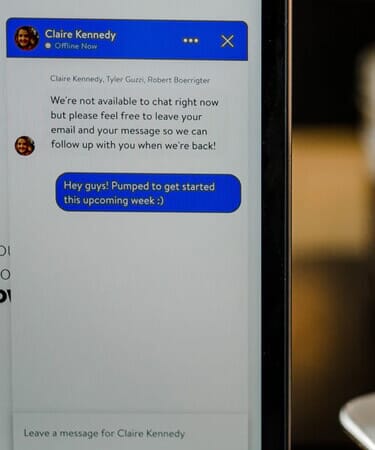In April 2016, Facebook announced that their Messenger platform would be launching its bot feature. The introduction of the bot promised a simplified way for brands to provide customer service and e-commerce solutions via content rich messages that could include images, links and call to action buttons.
A year later, Facebook Messenger had over 100,000 bots, with the most popular boasting thousands of interactions per day.
With such high levels of popularity, chatbots aren’t going anywhere, but what does this mean for the future of digital marketing?
What is a chatbot?
Chatbots are a conversational interface, powered by either rules or artificial intelligence (AI).
Bots powered by rules cater to simple requests; customer asks A, bot answers B. These bots are great at basic tasks, like making or cancelling appointments, but get stuck when faced with typos or commands beyond their programmed abilities.
Alternatively, chatbots based on AI understand natural language processing, giving them the potential to interpret complex requests, personalise their responses and even learn from their interactions over time.
Not restricted to Facebook Messenger, chatbots can also be integrated directly onto your business’ website, allowing visitors to have their burning questions answered in real time as they browse.
Thousands of businesses have developed automated bots with the aim to simplify their customer service offering. Many of these bots have seen huge levels of success, such as Danske Bank’s wealth management robot, known as June, who has served over 11,500 clients.
While many bots are succeeding with their customer service duties, a quick Google search of ‘chatbot fail’ offers numerous cases where bots have been stumped by consumer requests. Building an intelligent bot is no simple task, and there are many elements that must be considered to ensure your bot runs smoothly.
Remember, your bot will only be as intelligent as you make it!
Conversation is key
It is important to be transparent from the beginning of your bot’s conversation; your consumer is speaking with a bot, not a real person. This doesn’t mean that your bot shouldn’t emulate authentic human conversation, and we are strong believers that your chatbot should have a distinctive personality in order to effectively engage your consumers.
No matter how comprehensive your chatbot is, there are always going to be questions or statements that it doesn’t understand or can’t assist with. This is why having Easter eggs in your bot’s conversation copy are essential. Easter eggs are specially crafted messages or jokes that surface with the aim of defining your bot’s personality with a light-hearted joke, or getting your bot out of sticky situations by offering an alternative when faced with an ‘out there’ or unactionable request.
Consumer: Hey Bot – can you help me fly to the moon?
Bot: Woah, haven’t heard that one before! You can ask me something else or leave me feedback regarding a feature request by clicking here.
One step ahead
There are many factors that contribute to a chatbot’s intelligence. Chatbots powered by AI have an awareness of the user’s needs, with the capability of leading discussions and making intelligent suggestions. By accessing information regarding the location of the user, the weather of that location and even the availability of the item or service that they may be searching for, bots are able to pre-empt the direction of the conversation and ultimately provide more efficient and individually tailored customer service.
Consumer: Hey Bot – can you recommend me a café?
Bot: Of course! I see you’re in Pyrmont, Sydney. Would you like directions to the closest café or the top-rated café?
Consumer: Closest please.
Bot: The café closest to you is unfortunately closed today, but there is another café open 800 metres away. Would you like directions to this café instead?
To sum up
The buzz surrounding chatbots shows no sign of slowing down in 2018 and beyond with more brands beginning to use them as a customer service tool.
Does bot building sound like your next project? Get in touch with our Development team.









